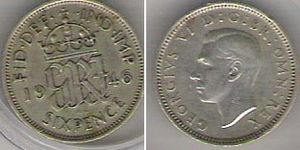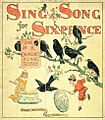Sixpence (British coin) facts for kids

The sixpence (also known as 6d) was a small British coin. People sometimes called it a tanner or a half-shilling. It was worth 6 old pennies. After the UK changed to a decimal money system, it was worth 2 and a half new pence.
The sixpence coin was first made in 1551. This was during the time Edward VI of England was king. The last sixpence coins were made in 1970. Even after 1970, the coin was still used for a while. It was finally taken out of use in 1980.
Contents
What Was a Sixpence?
A sixpence was a coin used in the United Kingdom for many years. It was part of the old British money system. This system was used before 1971. In the old system, there were 12 pennies in a shilling. There were 20 shillings in a pound. So, a sixpence was half of a shilling.
The sixpence was a popular coin. Many people used it every day. It was often given as a good luck charm. Sometimes, it was put into Christmas puddings. Finding it was thought to bring good fortune.
History of the Sixpence
The sixpence coin has a long history. It was first made in the year 1551. This was during the rule of Edward VI of England. Before this, people would cut larger silver coins in half. This was to make smaller change. The sixpence was created to make this easier.
Over the centuries, many different kings and queens were shown on the sixpence. Each new ruler would have their face on the coin. The design on the back of the coin also changed over time.
Materials Used
When the sixpence was first made, it was a silver coin. Silver was a common metal for coins back then. It was used for many years.
However, during World War II, silver became very expensive. So, after 1947, the sixpence was made from a different metal. It was made from cupronickel. This is a mix of copper and nickel. It looks like silver but is much cheaper to make.
Decimalisation and End of Use
On 15 February 1971, the UK changed its money system. This day is called Decimal Day. Before this, money was counted in pounds, shillings, and pennies. After this, it was counted in pounds and new pence.
The sixpence was still allowed to be used after Decimal Day. However, its value changed. It was no longer worth 6 old pennies. Instead, it was worth 2.5 new pence. This made it a bit tricky to use. Because of this, the sixpence was finally taken out of circulation in 1980.
Images for kids
-
Sixpence of Queen Elizabeth I, struck in 1593 at the Tower Mint
-
Obverse and reverse of the 1787 sixpence, depicting George III.
-
1887 sixpence showing the simpler reverse of SIX PENCE in the middle with Queen Victoria depicted on the obverse
-
Obverse and reverse of the 1928 sixpence, depicting George V
-
Cover illustration for Randolph Caldecott's picture book Sing a Song for Sixpence (1880)
See also
 In Spanish: Seis Peniques para niños
In Spanish: Seis Peniques para niños







